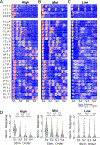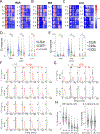NF-κB memory coordinates transcriptional responses to dynamic inflammatory stimuli
- PMID: 35977475
- PMCID: PMC10794069
- DOI: 10.1016/j.celrep.2022.111159
NF-κB memory coordinates transcriptional responses to dynamic inflammatory stimuli
Abstract
Many scenarios in cellular communication require cells to interpret multiple dynamic signals. It is unclear how exposure to inflammatory stimuli alters transcriptional responses to subsequent stimulus. Using high-throughput microfluidic live-cell analysis, we systematically profile the NF-κB response to different signal sequences in single cells. We find that NF-κB dynamics store the short-term history of received signals: depending on the prior pathogenic or cytokine signal, the NF-κB response to subsequent stimuli varies from no response to full activation. Using information theory, we reveal that these stimulus-dependent changes in the NF-κB response encode and reflect information about the identity and dose of the prior stimulus. Small-molecule inhibition, computational modeling, and gene expression profiling show that this encoding is driven by stimulus-dependent engagement of negative feedback modules. These results provide a model for how signal transduction networks process sequences of inflammatory stimuli to coordinate cellular responses in complex dynamic environments.
Keywords: CP: Immunology; NF-κB; cellular memory; inflammation; information theory; innate immune signaling; live-cell imaging; mathematical modeling; microfluidics; pathogen-associated molecular patterns; signaling dynamics.
Copyright © 2022 The Authors. Published by Elsevier Inc. All rights reserved.
Conflict of interest statement
Declaration of interests The authors declare no competing interests.
Figures







Similar articles
-
Processing stimulus dynamics by the NF-κB network in single cells.Exp Mol Med. 2023 Dec;55(12):2531-2540. doi: 10.1038/s12276-023-01133-7. Epub 2023 Dec 1. Exp Mol Med. 2023. PMID: 38040923 Free PMC article. Review.
-
NF-κB responds to absolute differences in cytokine concentrations.Sci Signal. 2021 Jan 19;14(666):eaaz4382. doi: 10.1126/scisignal.aaz4382. Sci Signal. 2021. PMID: 34211635 Free PMC article.
-
Computational modeling with forward and reverse engineering links signaling network and genomic regulatory responses: NF-kappaB signaling-induced gene expression responses in inflammation.BMC Bioinformatics. 2010 Jun 8;11:308. doi: 10.1186/1471-2105-11-308. BMC Bioinformatics. 2010. PMID: 20529327 Free PMC article.
-
Quantitative characterization and analysis of the dynamic NF-κB response in microglia.BMC Bioinformatics. 2011 Jul 5;12:276. doi: 10.1186/1471-2105-12-276. BMC Bioinformatics. 2011. PMID: 21729324 Free PMC article.
-
Insights on the NF-κB System Using Live Cell Imaging: Recent Developments and Future Perspectives.Front Immunol. 2022 Jun 29;13:886127. doi: 10.3389/fimmu.2022.886127. eCollection 2022. Front Immunol. 2022. PMID: 35844496 Free PMC article. Review.
Cited by
-
NFκB signaling in T cell memory.Front Immunol. 2023 Feb 24;14:1129191. doi: 10.3389/fimmu.2023.1129191. eCollection 2023. Front Immunol. 2023. PMID: 36911729 Free PMC article. Review.
-
Effect of traditional Chinese medicine in osteosarcoma: Cross-interference of signaling pathways and potential therapeutic targets.Medicine (Baltimore). 2024 Jan 19;103(3):e36467. doi: 10.1097/MD.0000000000036467. Medicine (Baltimore). 2024. PMID: 38241548 Free PMC article.
-
Single-nucleus proteomics identifies regulators of protein transport.bioRxiv [Preprint]. 2024 Jun 18:2024.06.17.599449. doi: 10.1101/2024.06.17.599449. bioRxiv. 2024. PMID: 38948785 Free PMC article. Preprint.
-
Co-imaging of RelA and c-Rel reveals features of NF-κB signaling for ligand discrimination.Cell Rep. 2024 Mar 26;43(3):113940. doi: 10.1016/j.celrep.2024.113940. Epub 2024 Mar 13. Cell Rep. 2024. PMID: 38483906 Free PMC article.
-
Processing stimulus dynamics by the NF-κB network in single cells.Exp Mol Med. 2023 Dec;55(12):2531-2540. doi: 10.1038/s12276-023-01133-7. Epub 2023 Dec 1. Exp Mol Med. 2023. PMID: 38040923 Free PMC article. Review.
References
-
- Adamson A, Boddington C, Downton P, Rowe W, Bagnall J, Lam C, Maya-Mendoza A, Schmidt L, Harper CV, Spiller DG, et al. (2016). Signal transduction controls heterogeneous NF-κB dynamics and target gene expression through cytokine-specific refractory states. Nat Commun 7, 12057. 10.1038/ncomms12057. - DOI - PMC - PubMed
Publication types
MeSH terms
Substances
Grants and funding
LinkOut - more resources
Full Text Sources
Molecular Biology Databases
Miscellaneous

